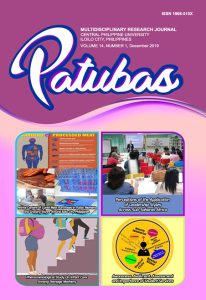
Patubas is published once a year under the auspices of Central Philippine University, Jaro, Iloilo City, Philippines.
Copyright © 2019 by individual authors and Patubas.
Published in 2019
Central Philippine University
Lopez Jaena, St., Jaro, Iloilo City
All rights reserved. No part of this publication may be reproduced or transmitted in any form or by any means, electronic or mechanical, including photocopy, recording or any information storage and retrieval system, without permission in writing from the authors or publisher.
For print ISSN 1908-515X
Publication ISSN 2672-3611
Opinions and facts contained in the articles published in this issue of Patubas are the sole responsibility of the individual authors and not of the Editorial Board, Patubas or Central Philippine University.89
GEORGE R. WEST, Ph.D., Central Philippine University
TARIKU FUFA GEMECHU, Ph.D., Regent University
ABSTRACT
Although some observers have argued that leadership has
improved in Africa, since the end of colonial times, others
have suggested that leadership problems have remained the
root causes of Africa’s multifaceted challenges (Adadevoh,
2006; Musekura & Ntamushobora, 2004). Still, others have
suggested that any continued leadership problems might
actually stem from less than adequate programs in African
higher education that have limited the number and types of
quality outputs (Haruna, 2009). This has resulted in a
subsequent call for university-industry interactions and quality
involvement in program development and education
management throughout the continent. Based on these, we
evaluated the perception of African stakeholders, from 11
different countries, regarding organizational applications, by
leaders, of Servant Leadership (Winston & Fields, 2015),
Leader Member Exchange (Graen & Uhl-Bien, 1995),
Contingent Reward Leadership (Reitz, 1971), and Autocratic
Leadership Style (Lewin, Lippit &White, 1939). We found that
perceptions of students and professionals differ, regarding
servant leadership and autocratic leadership. We also
evaluated the perceptions of stakeholders, regarding the
quantity and quality of professionals’ general involvement with
universities and in teaching and educational development of
university students. In these areas, we found that perceptions of students and professionals differ, regarding professionals’
general involvement with universities.
JUN OZBERT M. HAGUISAN, M.A. Chem.
ANN MARIE P. ALGUIDANO, M. Chem.
Central Philippine University
ABSTRACT
Nitrates and nitrites are used as preservatives, affects flavor
and develop cured meat color. Too much nitrite from meat
could produce nitrosamines which are related to spontaneous
intrauterine growth restriction, abortions, birth defects and
Methemoglobinemia or “blue baby syndrome”, and especially
cancer. This study aimed to determine the concentration of
nitrite in different processed meats purchased from markets
and grocery stores around Iloilo City and to compare to the
levels set by BFAD. Cured samples of hotdog, ham,
longganiza, chorizo and tocino were purchased from different
public markets and grocery stores around Iloilo City. The
nitrite content of these cured meat products were analyzed
using a UV-Vis spectrophotometer and the results were within
the limits set by BFAD which is 416ppm for chorizo,
longganiza and tocino; 134ppm for hotdogs and168ppm for
ham. The Acceptable Daily Intake (ADI) of 0.07 mg nitrite per
kg body weight was set by JECFA-WHO/FAO. On the basis
of a 65kg body weight, daily consumption must not exceed
42g, 117g, 170g, 262g, and 94g for chorizo, tocino,
longganiza, ham and hotdog respectively. On the basis of a
25kg child, the hotdog consumption must not exceed 36g. It is advised to eat cured meats in moderation to prevent the bad effects of nitrite consumption.
JULIETA H. BOTEROS, M.A.N.
NOVIE JOY C. SOLEDAD, M.N.
Central Philippine University
ABSTRACT
This study, using the descriptive phenomenological approach,
explored the infant care experience of teenage mothers using a
descriptive. Seven teenage mothers, ages 15-19 years old, were
interviewed. These participants came from diverse educational,
socio- economic, and geopolitical backgrounds, who were
primary caregivers of their children 0-12 months old at the time
of the interview and delivered termed babies without any
congenital disorders regardless of the method of delivery. The
interview with teenage mothers was recorded using a digital
recorder and was transcribed using Hycner’s (1985) method.
Findings of the study showed that essence of the infant care
experience of teenage mothers is characterized by four major
themes: adapting to infant care routines, facing challenges in
infant care, adjusting to become a teenage mother, and feeling
of fulfillment of motherhood experience. These teen mothers
cared for their babies with support from their families, partners
and significant others. Some of them regretted becoming
mothers at an early age and deprived of social life, sleep, and
time for self. They desired for self-improvement and tried to
manage time. They may be young, but they feel happy and
fulfilled seeing their babies grow.
MARGEN A. JAVA, EdD, RGC
MAREDIL E. AMBOS, Ed.D.
GIFT D. TRAGICO, MAEd, RGC
BETTY C. ERMITAÑO, MAEd, RGC.
EUNICE G. ALAYON, MSGC, RGC
ROUELLA CHEYENNE C. ABERIA, AB
Central Philippine University
ABSTRACT
This descriptive-relational study was conducted to determine
the awareness, availment, assessment, and importance of
student services among the 361 students of Central Philippine
University during the School Year 2018 – 2019. A revised duly
validated and reliability tested questionnaire was used and
ethical considerations for the study were followed. Data were
analyzed using frequency count, percentages, Chi Square,
Cramer’s V, and Gamma. The findings are: the profile of the
respondents shows that there are more females than males;
younger group; Roman Catholics; first and fourth year
students from the Colleges of Business and Accountancy,
Engineering and Arts and Sciences; coming from barangays;
graduated from either public or private high schools either
located in the cities or towns; and are living with their parents
in their own house while studying in the university. The
respondents are very much aware of the existence of the
student services and programs of the university during the two
school years of the survey (2015 and 2018); have attached a
great value upon the existence of these student services and
programs in the university; are aware and have availed of the
services and programs under the VPSA. Based on the findings of the study, the following conclusions are drawn: the
respondents’ place of origin is significantly related to the
importance they attach to student services and programs in
general of the university. The respondents’ awareness of
student services and programs under the Office of the Vice
President for Student Affairs is significantly related to their
availment and assessment of these services and programs.
